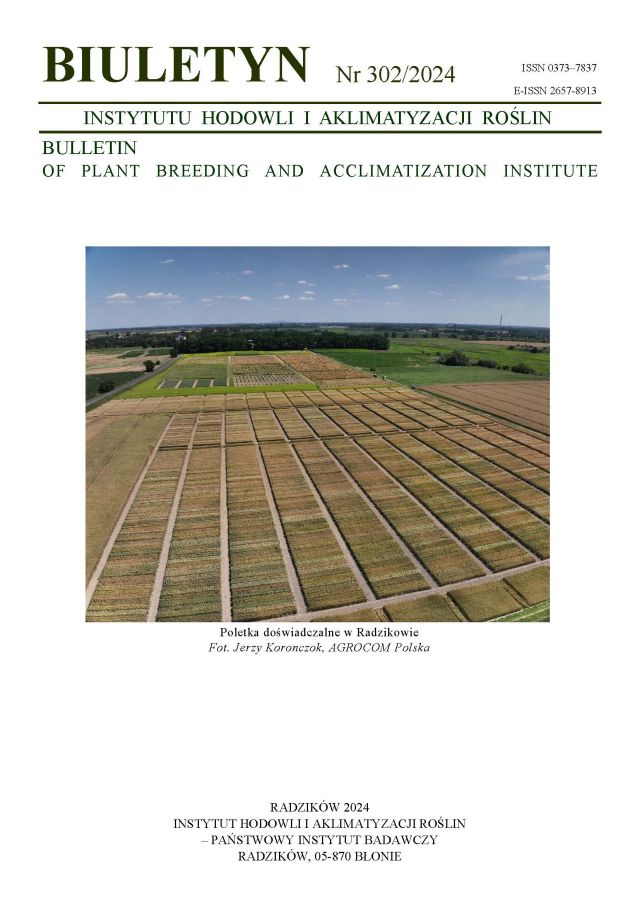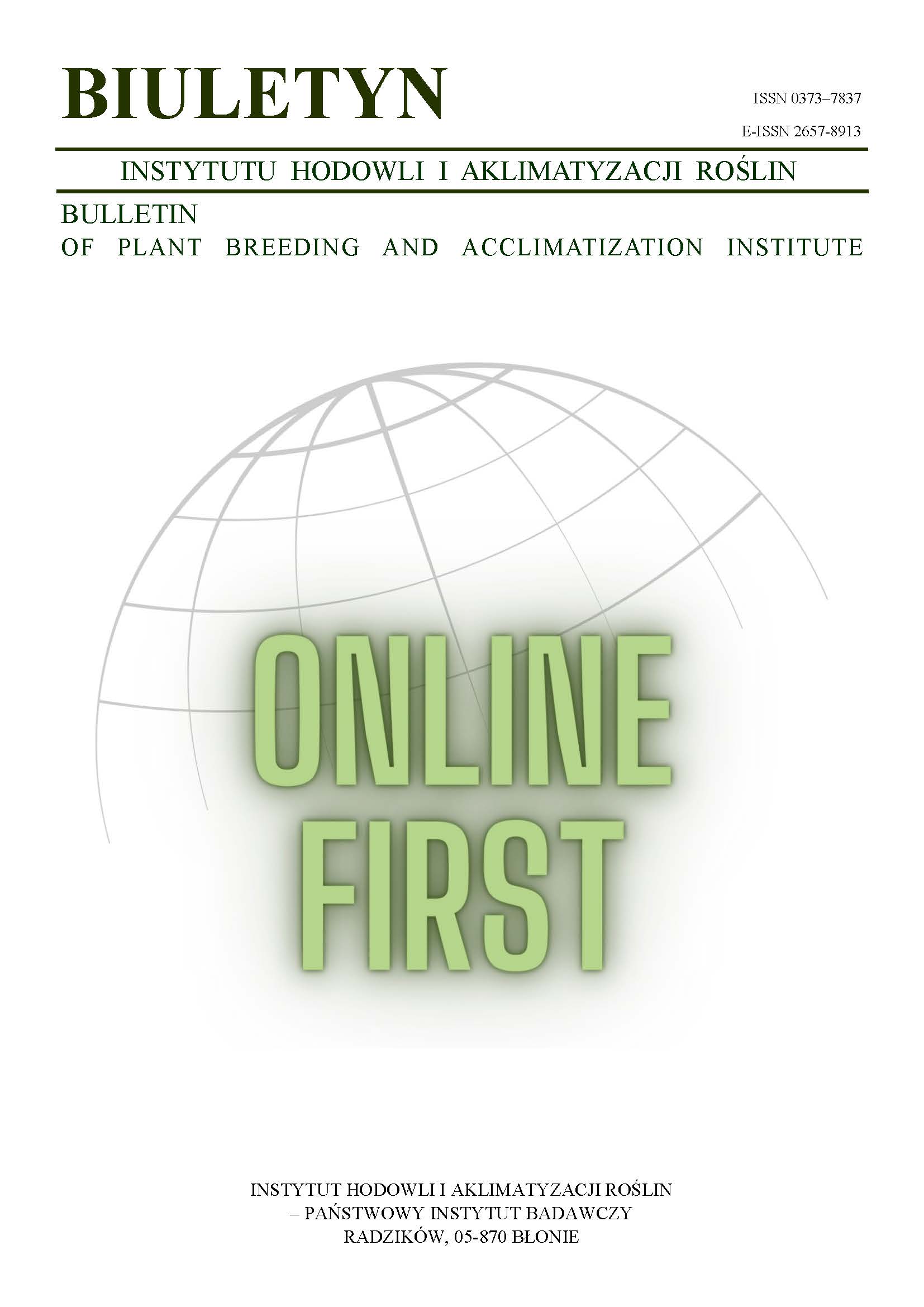Variation and relationships between quality parameters in malting barley harvested in 2004
Magdalena Ploch
m.ploch@ihar.edu.plPracownia Oceny Jakości Produktów Roślinnych, Zakład Biochemii i Fizjologii Roślin, Instytut Hodowli i Aklimatyzacji Roślin, Radzików (Poland)
Małgorzata Cyran
Pracownia Oceny Jakości Produktów Roślinnych, Zakład Biochemii i Fizjologii Roślin, Instytut Hodowli i Aklimatyzacji Roślin, Radzików (Poland)
Katarzyna Kasztelowicz
Pracownia Oceny Jakości Produktów Roślinnych, Zakład Biochemii i Fizjologii Roślin, Instytut Hodowli i Aklimatyzacji Roślin, Radzików (Poland)
Danuta Boros
Pracownia Oceny Jakości Produktów Roślinnych, Zakład Biochemii i Fizjologii Roślin, Instytut Hodowli i Aklimatyzacji Roślin, Radzików (Poland)
Janusz Burek
Zakład Roślin Zbożowych, Instytut Hodowli i Aklimatyzacji Roślin, Kraków (Poland)
Abstract
The malting quality of spring barley harvested in 2004 was evaluated for 60 breeding lines and 3 standard cultivars grown in preliminary and pre-preliminary field trials at ZD HAR Strzelce, SHR Modzurów and ZD HAR Radzików. The malting quality was estimated on the basis of the following parameters: 1000 grains weight, grain plumpness, total grain protein, total and soluble malt protein, Kolbach index, malt friability, extractability, wort viscosity, diastatic power, content of beta-glucan and final fermentation degree. Coefficients of variation (CV%) and correlation were estimated for the investigated traits. The influence of environment was the highest for malt friability, protein and beta-glucan content.
Keywords:
beta-glucan, malt, malting quality, spring barley, variabilityReferences
Aufhammer G., Fischbeck G. 1971. Location differences in grain yield, yield structure and grain quality of two-rowed and multi-rowed winter and spring barley. Z. Acker.-u. Pfl. Bau., 133, 3: 169 — 181.
Google Scholar
Aufhammer G., Mandl B., Molitoris K., Piendl A. 1970. Influence of fertilizer application on the composition of malt of various barley varieties. Brauwelt. 110: 1125 — 1130.
Google Scholar
Bichoński A. 2003. Zmienność i współzależność wybranych cech technologicznych jęczmienia jarego browarnego. Biul. IHAR 228: 105 — 110.
Google Scholar
Bichoński A., Burek J. 2000. Zmienność i współzależność pomiędzy wybranymi cechami jakościowymi jęczmienia ozimego browarnego. Biul. IHAR 215: 161 — 166.
Google Scholar
Brandenburger V. 1973. The influence of environment on yield and quality of malting barley. Monats. Brau., 15: 1 — 9.
Google Scholar
Garcera L., Sarraft A., Jestin L., Ecochard R. 1991. Variabilite genetque de certaina parametres de la qualite Brassicole de l’Orge. Plant Breeding 106: 235 — 241.
DOI: https://doi.org/10.1111/j.1439-0523.1991.tb00506.x
Google Scholar
Gąsiorowski H. 1997. Jęczmień-Chemia i Technologia. PWR i L, Poznań.
Google Scholar
Janicki J. 1949. Jęczmień browarny. PZZ, Warszawa.
Google Scholar
Kowalska M. 1973. Wpływ odmiany i środowiska na wartość browarną jęczmienia na podstawie literatury. Biul. IHAR 114/115: 53 — 58.
Google Scholar
Kowalska M., Ruśniak L. 1970. Wpływ zwiększonego nawożenia mineralnego na plon i wartość technologiczną odmian jęczmienia browarnego. Biul. IHAR 96/97: 33 — 39.
Google Scholar
Molina-Cano J. L. 1987. The EBC Barley and Malt Committee Index for the evaluation of malting quality in barley and its use in breeding. Plant Breeding 98: 249 — 256.
DOI: https://doi.org/10.1111/j.1439-0523.1987.tb01124.x
Google Scholar
Ruśniak L. 1968. Wpływ warunków wzrostu i rozwoju na plon i wartość browarną jęczmienia. Hod. Rośl. Aklim. 12/3: 237 — 267.
Google Scholar
Schildbach R. 1696. The influence of growing location and nitrogen fertilization on the quality of barley, wheat and malt. Monats. Brau. 22: 361 — 369.
Google Scholar
Schildbach R. 1972. Vorhersage der Qualität von Malz und Bier aus den Analysen von Gerste und Malz. Monats. Brau. 25: 309 — 319.
Google Scholar
Schildbach R. 1973. Yield versus quality malting barley? Monats. Brau. 26: 73 — 83.
Google Scholar
Schildbach R. 1974. Reason for variation in the protein content of malting barley. Monats. Brau. 27: 204 — 217.
Google Scholar
Słaboński A. 1976. Jęczmień jary i ozimy. PWR i L Warszawa.
Google Scholar
Swanston J. S., Eblis R. P., Rubio A., Perezvendrell A., Molina-Cano J. L. 1995. Differences in malting performance between barleys grown in Spain and Scotland. Journal of the Institute of Brewing. 101 (4): 261 — 265.
DOI: https://doi.org/10.1002/j.2050-0416.1995.tb00864.x
Google Scholar
Ulonska E., Baumer M. 1975. Studies on the influence of different selection conditions on the selection success as regards protein quantity and quality. Proc. 3rd Int. Barley Genet. Symp.: 125 — 126.
Google Scholar
Vargas L., Molina-Cano J. L., Hassan S. 1983. A quality index for the assessment of barley varieties. Monatsschr. Brauwissen. 12:481 — 485.
Google Scholar
Węgrzyn S., Bichoński A. 2001. Zróżnicowanie i genetyczne uwarunkowanie cech wartości technologicznej jęczmienia jarego browarnego. Biul. IHAR 220: 153 — 159.
Google Scholar
Authors
Magdalena Plochm.ploch@ihar.edu.pl
Pracownia Oceny Jakości Produktów Roślinnych, Zakład Biochemii i Fizjologii Roślin, Instytut Hodowli i Aklimatyzacji Roślin, Radzików Poland
Authors
Małgorzata CyranPracownia Oceny Jakości Produktów Roślinnych, Zakład Biochemii i Fizjologii Roślin, Instytut Hodowli i Aklimatyzacji Roślin, Radzików Poland
Authors
Katarzyna KasztelowiczPracownia Oceny Jakości Produktów Roślinnych, Zakład Biochemii i Fizjologii Roślin, Instytut Hodowli i Aklimatyzacji Roślin, Radzików Poland
Authors
Danuta BorosPracownia Oceny Jakości Produktów Roślinnych, Zakład Biochemii i Fizjologii Roślin, Instytut Hodowli i Aklimatyzacji Roślin, Radzików Poland
Authors
Janusz BurekZakład Roślin Zbożowych, Instytut Hodowli i Aklimatyzacji Roślin, Kraków Poland
Statistics
Abstract views: 118PDF downloads: 20
License
Copyright (c) 2005 Magdalena Ploch, Małgorzata Cyran, Katarzyna Kasztelowicz, Danuta Boros, Janusz Burek

This work is licensed under a Creative Commons Attribution-ShareAlike 4.0 International License.
Upon submitting the article, the Authors grant the Publisher a non-exclusive and free license to use the article for an indefinite period of time throughout the world in the following fields of use:
- Production and reproduction of copies of the article using a specific technique, including printing and digital technology.
- Placing on the market, lending or renting the original or copies of the article.
- Public performance, exhibition, display, reproduction, broadcasting and re-broadcasting, as well as making the article publicly available in such a way that everyone can access it at a place and time of their choice.
- Including the article in a collective work.
- Uploading an article in electronic form to electronic platforms or otherwise introducing an article in electronic form to the Internet or other network.
- Dissemination of the article in electronic form on the Internet or other network, in collective work as well as independently.
- Making the article available in an electronic version in such a way that everyone can access it at a place and time of their choice, in particular via the Internet.
Authors by sending a request for publication:
- They consent to the publication of the article in the journal,
- They agree to give the publication a DOI (Digital Object Identifier),
- They undertake to comply with the publishing house's code of ethics in accordance with the guidelines of the Committee on Publication Ethics (COPE), (http://ihar.edu.pl/biblioteka_i_wydawnictwa.php),
- They consent to the articles being made available in electronic form under the CC BY-SA 4.0 license, in open access,
- They agree to send article metadata to commercial and non-commercial journal indexing databases.
Most read articles by the same author(s)
- Danuta Boros, Damian Gołębiewski, Components determining the nutritive and functional values of oat and its relation between hulled and dehulled grains , Bulletin of Plant Breeding and Acclimatization Institute: No. 286 (2019): Special issue
- Magdalena Wiśniewska, Danuta Boros, Józef Zych, Nutritional value of selected mixtures of spring cereals with legumes , Bulletin of Plant Breeding and Acclimatization Institute: No. 289 (2020): Regular issue
- Wioletta Dynkowska, Małgorzata Cyran, Bioactive substances of wheat input forms for new breeding cultivation in the aspect of functional food production , Bulletin of Plant Breeding and Acclimatization Institute: No. 287 (2019): Special issue
- Damian Gołębiewski , Danuta Boros, Kinga Gołębiewska, Anna Fraś , Nutritive and bioactive potential of oat cultivars , Bulletin of Plant Breeding and Acclimatization Institute: No. 287 (2019): Special issue
- Lech Boros, Anna Wawer, Magdalena Wiśniewska, Danuta Boros, Effect of genotype and contrasting climate conditions on physical and chemical characteristics of soybean (Glycine max L. Merrill) , Bulletin of Plant Breeding and Acclimatization Institute: No. 296 (2021): Regular issue
- Danuta Boros, Alkylresorcinols of cereal grains — their importance in food and feed , Bulletin of Plant Breeding and Acclimatization Institute: No. 277 (2015): Regular issue
- Kinga Myszka, Beata Kamińska, Anna Fraś, Magdalena Ploch, Danuta Boros, Dumas method as an alternative approach for determining protein contents of plant products — comparative study with Kjeldahl method , Bulletin of Plant Breeding and Acclimatization Institute: No. 260/261 (2011): Regular issue
- Danuta Boros, Magdalena Wiśniewska, Marlena Gzowska, Józef Zych, Edward Gacek, Improvement of the spring wheat nutritional value by sowing variety mixtures , Bulletin of Plant Breeding and Acclimatization Institute: No. 289 (2020): Regular issue
- Danuta Boros, Kinga Gołębiewska, Components determining the low protein digestibility of meal obtained from seeds of winter rapeseed , Bulletin of Plant Breeding and Acclimatization Institute: No. 286 (2019): Special issue
- Damian Gołębiewski, Kinga Myszka, Anna Fraś, Danuta Boros, Janusz Burek, Dariusz R. Mańkowski, Evaluation of genetic and environmental variability of traits that determine malting quality of spring barley lines from preliminary trials in 2012 , Bulletin of Plant Breeding and Acclimatization Institute: No. 268 (2013): Regular issue














